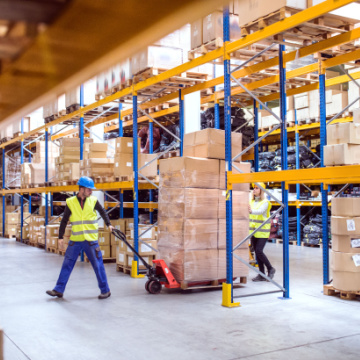When we hear about a warehouse, the first thing that comes to our mind is a dusty, noisy, and distracting work environment. Warehouse workers regularly perform repetitive work and deal with conditions that are less than ideal for their safety. As a result of their inherent nature, working in warehouses exposes workers to different types of mishaps including slips, trips, falls, forklift accidents, repetitive stress injuries, and more. The good news is that many of these risks can be addressed by advanced technology tools designed specifically to improve warehouse safety.
As a result of the explosion of e-commerce in recent years, the pressure on the warehouse industry to fulfil orders has increased significantly. Warehouse employees are now under constant pressure to pick orders in a timely manner, maintain accurate inventory, and deliver packages swiftly. Their bodies suffer serious strain resulting from constant stretching, reaching, bending, walking, and lifting. Moreover, they also need to be extremely cautious to avoid injuries resulting from falling objects, collisions, and other hazards.
Luckily, however, the logistics and warehouse industry has come a long way from its early days. As technology has evolved over the years, new innovations have made warehouses a considerably safer place for workers. Many warehouses have now addressed their workplace security concerns using sensors, automation, virtual reality, drones, and other technological innovations.
Proximity Warnings Using RFID Sensors:
Radio frequency identification or RFID sensors are extremely useful tools for warehouse worker safety. In addition to helping in inventory tracking, these sensors are invaluable from the perspective of accident prevention. Whenever a worker is found close to a potentially dangerous area, proximity warnings are generated by RFID tags and sensors. With the help of these systems, it is possible to restrict workers from wandering into the path of heavy equipment, preventing injuries and saving lives.
Forklift Safety Technology:
A high percentage of serious injuries and fatalities in warehouses can be attributed to forklifts. Many warehouses nowadays use automated guidance systems to ensure that forklifts are able to move on their own, avoiding collisions with people and objects using lasers. Forklift accidents can also be minimised by regular equipment repair and maintenance.
Wearable Technology:
Wearable technology has many useful applications in warehouses. For example, the process of picking and packing can become more seamless by using wireless headsets. This reduces workers walking back and forth to receive instructions, and protects them from accidents and injuries resulting from fatigue. Use of wearable fitness trackers capable of reporting heart rate and body temperature can alert employers whenever a worker is in a risk situation that can lead to an occupational hazard.
Warehouse Drones:
Drones can capture inventory data in a warehouse using RFID technology. As a result, workers are no longer required to use lifts or climb ladders for inventory control. Drones can also be used to relieve human workers from equipment inspection.
Occupancy Sensors:
Poor lighting is a common reason behind warehouse accidents and injuries. If workers are not able to see things around them, they are extremely likely to walk into potentially dangerous areas or trip over something dangerous. Occupancy sensors can turn lights on and off by sensing movement, eliminating the need for workers to turn lights on while walking into an area.
If you own or manage a warehouse, you may want to take a look at the advanced range of warehouse accident prevention solutions from ShockWatch. We have top-notch pedestrian alert systems, collision avoidance systems, blind spot systems, and much more, all designed specifically for warehouses.


